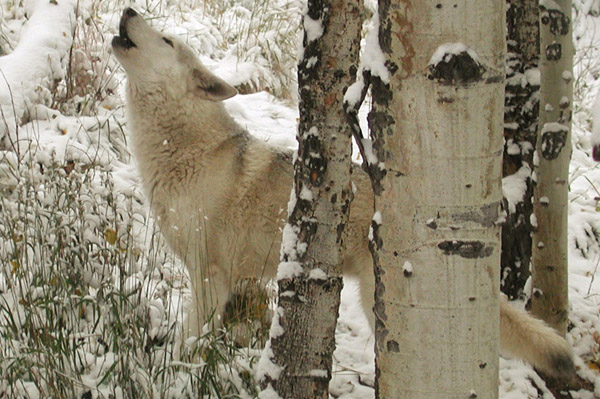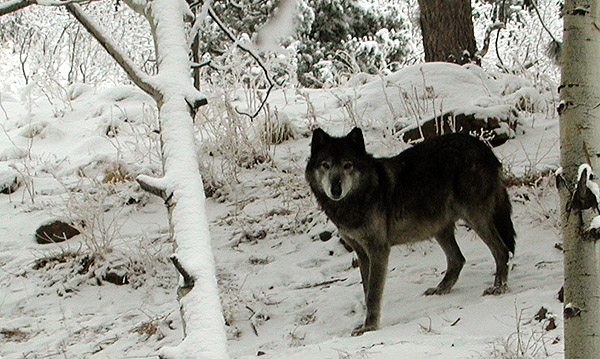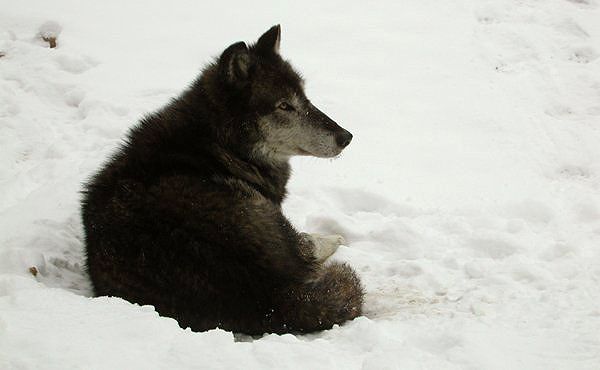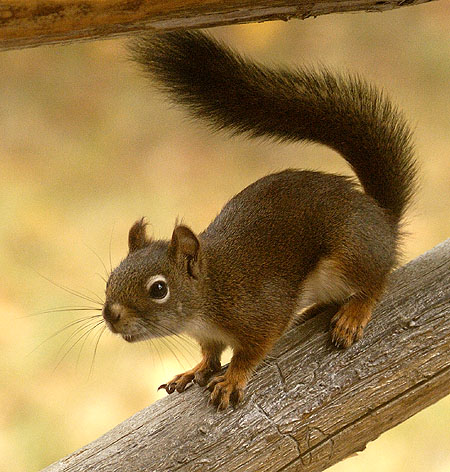The Weekly Wolf
I spent six years living with the wolves of
Mission:Wolf.
Each Monday, this page will feature a photograph and story
of these wolves or a fellow species from the gray wolf's ecosystem.
April 25, 2011

Spirit
Spirit is a white female wolf-dog cross who came to Mission:Wolf in 2003. Her previous owners used Spirit as a puppy mill, breeding her with a malamute and selling the puppies to the highest bidder. Eventually her owners abandoned Spirit and her latest litter of pups in a hotel tennis court. The hotel managers did their best to find homes for all of the animals, but Spirit looked and acted far too wolfy to fit into someone’s home. The hotel managers could only see one solution – they set her free.
A recently freed wolf or wolf-dog will usually run up to the first person they see, looking for food, and get shot out of fear. When this doesn’t happen, the animal stays in the woods and starves to death because it doesn’t know how to hunt. Thankfully, a couple of kind people found Spirit running loose, recaptured her and called Mission:Wolf for help.
When she first arrived at the refuge Spirit had little confidence and shied away from everyone. We hoped that introducing her to Mowgli, a strong alpha male wolf, would help her calm down. Introducing wolves to each other usually takes months to work because wolves are so suspicious of new members in their pack. However, after only two weeks, Spirit and Mowgli were the best of friends. In the years they spent together Mowgli taught Spirit to be more outgoing around strangers and showered her with affection. They became the sweethearts of the refuge and could always be found laying in the sunshine close together.
Sadly, Mowgli passed away in the winter of 2009, leaving Spirit scared and alone. She retreated back into her shell and seemed to wait for her beloved Mowgli to reappear. The refuge had recently taken in several new animals and we hoped that one of them could serve as a new companion for Spirit. We introduced her to an extremely insecure male wolf-dog named Sangre, and the two hit it off immediately. Surprisingly, Sangre’s panic-y barking and erratic behavior around humans encouraged Spirit to get over her shyness and try to show the silly newcomer that humans were okay. Today, Spirit and Sangre enjoy regular visits with refuge staff and visitors. Recently they even made a journey down to the staff kitchen for some extra attention – a feat many of us never expected to see.
April 18, 2011

Aspen
Aspen was one of the largest male wolves at Mission:Wolf, weighing well over 100 pounds. For the first five years of his life, Aspen lived with a large, older, alpha male wolf named Zephyr and a female his age named Whisper. Whisper paired with Zephyr and together they picked on Aspen, making him the scapegoat of the pack. As breeding season approached in 1999, Aspen suddenly, and without warning, challenged Zephyr and took over leadership of the pack. They both ended up with several minor wounds but Aspen came out on top holding his tail high. Zephyr was relocated to a new enclosure and Aspen was given the chance to be the alpha male. Aspen and Whisper grew to be very close, often lying in the shade of their aspen grove together and shyly slipping away if any visitors came too close.
Aspen always had a very loving and gentle nature, except when male staff came down to check on him during breeding season. He would then rush up to the fence growling to scare the men away from his mate. Whisper would do the same thing to any female staff that came down during breeding season. Consequently, Aspen and Whisper spent much of each winter enjoying their privacy while we tried to watch from afar.
When Whisper passed away in July of 2006, Aspen was left alone for the first time in his life. After much consideration, we introduced a little female wolf named Kestrel to him. They spent two happy years together, howling in unison and enjoying life before Kestrel also passed away. Even when left alone, Aspen remained a gentle and loving soul. He sought out affection from the Mission:Wolf staff and even started sticking around when visitors helped with his daily feeding. Sadly, after nearly 16 years of life, Aspen passed away in January of 2009.
April 11, 2011

Obediah
Obediah, affectionately known as “Obi-one Kanobi” and “Obi,” was a black male wolf born in April of 1993 to Nikkolah and Raven, two Mission:Wolf residents. Much to our surprise, Nikkolah had climbed to the top of the fence separating him from the females during breeding season and jumped over to mate with Raven. Of the six pups in his litter, Obi was probably the most reserved around people. While he was very playful around other wolves, Obediah was known for curiously sneaking up behind a tour group while they were looking at another enclosure and then quickly slipping away as soon as someone noticed he was there.
Obi spent his first three years living with his parents and a few other young wolves. However, as the youngsters hit maturity and started challenging the older wolves for leadership, the large pack had to be broken up. Obediah and a huge female wolf named Hina were moved into the steep ravine enclosure next to their old pack-mates. They quickly became great friends and were rarely found far from one another. Obediah adored Hina so much that whenever he caught a magpie, he offered it to her before eating it himself.
After Hina passed away in February 2008, Obediah started looking to humans for companionship for the first time. We often found him eagerly awaiting tour groups instead of trotting off into the trees. After a few months on his own, Obi even welcomed a few staff members into his enclosure for quick visits. It didn’t take long for the now ancient Obi to become a crowd favorite. Then, as the flow of visitors ebbed with the coming of fall, Obediah started going down hill. His old age was finally catching up to him. Sadly, in December of 2008, Obi passed away. Even though he’s gone, I still expect to hear his unusual siren-like howl whenever the wolves take up their call.
April 4, 2011

Red Squirrel
North American red squirrels (Tamiasciurus hudsonicus), not to be confused with Eurasian red squirrels, are a common sight in the coniferous forests of Canada, Alaska, the Northern US, and all along the Rocky Mountains. With the exception of one endangered population in Arizona, red squirrels are so abundant that they have recently begun expanding their range to include previously uninhabited deciduous forests. These bold, acrobatic squirrels can be distinguished from other North American tree squirrels by their small size, territoriality, reddish coat with a white underbelly, and a distinctive white ring around each eye. Though there is variation between the 25 recognized subspecies, red squirrels are typically 11-13 inches long from nose to tail tip and weigh only 5-8 ounces.
Red squirrels are probably best known for their chattering voices and boisterous treetop antics. Intensely territorial, North American red squirrels will scold trespassers of all species with loud chatters, chirps, rattles, growls, foot stomping and tail flicking. Nearly every stand of evergreens holds a few red squirrels ready to give passing hikers a piece of their mind and will determinedly escort the intruders down the path. Their loud alarm calls are so prevalent in the north woods that red squirrels are often referred to as Chickarees.
These little creatures are perfectly adapted to life in the trees, showing amazing agility while skipping from branch to branch at full speed on their constant search for food. Also known as pine squirrels, North American red squirrels feed primarily on highly caloric pine, fir, spruce and cedar seeds in order to fuel their hyperactive metabolisms. When conifer cones can’t be found, red squirrels will turn to other food sources including: tree buds, needles, and leaves; mushrooms and truffles; nuts; berries; flowers; tree sap; and occasionally bird eggs, nestlings, baby rabbits, and mice. Each squirrel creates a central cache containing hundreds of harvested cones and treats, called a midden, to see them through the winter. Once the snow starts to fall, red squirrels retreat into their well-hidden nests, only venturing out during warm spells or through tunnels under the snow to their food caches.
Here in the Northern Rocky Mountains, red squirrels are just emerging from their winter nests and are once again filling the forest with their characteristic chirps. April inevitably heralds the return of spring to the north woods, and with it breeding season for the squirrels. Their courtships are flashy affairs, with long, leaping chases through the trees and a constant barrage of chatter. A female will typically leave her territory to search out males and will mate with up to 16 of them in the single day of her fertility. By late May she will have given birth to 3-6 offspring and will then spend the summer raising them. By the time winter rolls around again the babies will have had to establish their own territories and collect enough conifer cones to see them through to the next spring. Sadly, only 22% of all baby red squirrels survive their first year, most falling victim to Canadian lynx, bobcats, coyotes, great horned owls, northern goshawks, red-tailed hawks, crows, martens, red foxes, gray foxes, weasel, and young wolves. However, the tough little red squirrels that do make it through their first winter have a long life of 5-8 years ahead of them. The brave red squirrel pictured above climbed up on the porch railing while I was sitting just a few feet away to chatter at me and let me know he had survived the long winter and was back to claim is territory in the front yard once again.
